| Allen Formation | |
|---|---|
| Stratigraphic range: Mid Campanian-Maastrichtian ~ | |
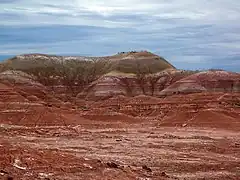 Outcrop of the Allen and Anacleto Formations at Auca Mahuida | |
| Type | Geological formation |
| Unit of | Malargüe Group |
| Underlies | Jagüel Formation |
| Overlies | Anacleto Formation |
| Thickness | up to 70 m (230 ft) |
| Lithology | |
| Primary | Mudstone, sandstone |
| Other | Limestone |
| Location | |
| Coordinates | 40°00′S 66°36′W / 40.0°S 66.6°W |
| Approximate paleocoordinates | 42°48′S 52°12′W / 42.8°S 52.2°W |
| Region | Neuquén, Río Negro & La Pampa Provinces |
| Country | Argentina |
| Extent | Neuquén Basin |
| Type section | |
| Named by | Uliana & Dellapé |
| Year defined | 1981 |
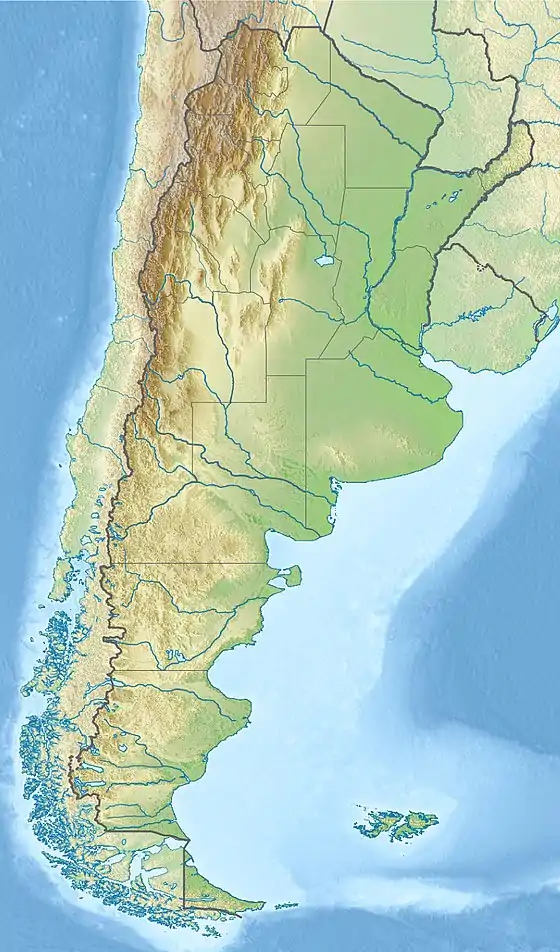 Allen Formation (Argentina) | |
The Allen Formation is a geological formation in Argentina whose strata date back to the Late Cretaceous (middle Campanian to early Maastrichtian.[1] Dinosaur remains are among the fossils that have been recovered from the formation.[2] Indeterminate chelid remains and other vertebrates have also been discovered in this formation.[3]
Description

The stratotype of the formation was defined by Uliana and Dellapé in 1981 in the eastern area of the Bajo de Añelo, where the relation between base and top is clearly exposed. The deposits are mostly clastic, interbedded with banks of limestone and layers of anhydrite, which were defined continental and shallow marine facies associated with semiarid conditions.[4]
The interpreted sedimentary paleoenvironments range from purely continental such as ephemeral lacustrine, aeolian and fluvial systems to coastal marine paleoenvironments with development of estuaries and tidal flats, followed by a lagoon sedimentary stage from marsh to sea with carbonate precipitation in an area protected from waves, ending with a retraction leading to the accumulation of evaporites.[4]
A detailed facies analysis of the formation was performed by Armas and Sánchez in 2015, where the authors concluded the formation represents a hybrid coastal system of tidal flats, dominated by Atlantic ingressions, with a large storm influence in some areas linked to aeolian systems.[5]
Fossil content
Dinosaurs
Dinosaur eggs are known from the formation.[6]
- Sauropods
| Sauropods reported from the Allen Formation | ||||||
|---|---|---|---|---|---|---|
| Genus | Species | Location | Stratigraphic position | Material | Notes | Images |
| Aeolosaurus | Indeterminate | Lower |  | |||
|
B.reigi[7] |
Río Negro Province[7] | Lower | Braincases, caudal vertebrae, and several limb elements | |||
| Menucocelsior | M. arriagadai | Lower | Seventeen caudal vertebrae and several appendicular bones: a right humerus, a left fibula and some metapodial. | |||
| Panamericansaurus | P. schroederi | "Five tail vertebrata, sacral vertebrae, left humerus and rib fragments" | ||||
| Pellegrinisaurus? | P. powelli | Lower (if it is from the formation) | "Dorsal and caudal vertebrae, partial femur" |  | ||
| Rocasaurus | R. muniozi | Lower | "Partial postcranial skeleton" | |||
- Ornithiscians
- Ankylosaur
| Ankylosaurs reported from the Allen Formation | ||||||
|---|---|---|---|---|---|---|
| Genus | Species | Location | Stratigraphic position | Material | Notes | Images |
| Patagopelta | P. cristata | Lower | Tooth, three posterior dorsal vertebrae, caudal vertebrae, two caudal centra, right femur, partial cervical half ring, and osteoderms. | |||
- Hadrosaur
| Hadrosaurs reported from the Allen Formation | ||||||
|---|---|---|---|---|---|---|
| Genus | Species | Location | Stratigraphic position | Material | Notes | Images |
| Bonapartesaurus | B. rionegrensis | Lower | ||||
| Kelumapusaura | K. machi | Upper | Partial skull, a cervical vertebrae, several sacrals, sternal rib and sternal plate and multiple referred specimens found in a bonebed | 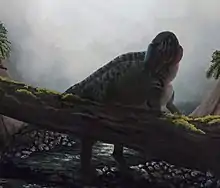 | ||
| Lapampasaurus | L. cholinoi | Lower | Elements of the axial and appendicular skeleton of a subadult individual | |||
| Willinakaqe | W. salitralensis | Lower | ||||
- Theropods
| Theropods reported from the Allen Formation | ||||||
|---|---|---|---|---|---|---|
| Genus | Species | Location | Stratigraphic position | Material | Notes | Images |
| Austroraptor | A. cabazai | Lower | 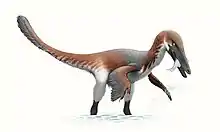 | |||
| Bonapartenykus | B. ultimus | Upper | ||||
| Lamarqueavis | L. australis | Lower | "Right coracoid with damaged sternal and omal extremities, and lacking acrocoracoidal process" | |||
| Limenavis | L. patagonica | Lower | "Partial forelimb" | |||
| Niebla | N. antiqua | Upper | Braincase, fragmentary jaw and teeth, relatively complete scapulocoracoid, dorsal ribs, and incomplete vertebrae. | [18] | 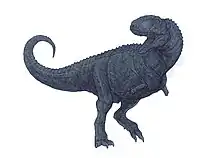 | |
| Quilmesaurus | Q. curriei | Upper | Femur and distal tibia | |||
Pterosaurs
Fragmentary fossils are known from the formation.[6]
| Pterosaurs reported from the Allen Formation | ||||||
|---|---|---|---|---|---|---|
| Genus | Species | Location | Stratigraphic position | Material | Notes | Images |
| Aerotitan | A. sudamericanus | Bajo de Arriagada | Uppermost Allen Fm. | Partial rostrum | The first unambiguous azhdarchid from South-America[20] |  |
Fish
| Fish reported from the Allen Formation[3] | ||||||
|---|---|---|---|---|---|---|
| Genus | Species | Location | Stratigraphic position | Material | Notes | Images |
| Diplomystidae | indeterminate | 4 incomplete pectoral spines | ||||
| Siluriformes | indeterminate | 5 incomplete pectoral spines | ||||
| Lepisosteidae | indeterminate | 6 vertebral centra | ||||
| Teleostei | indeterminate | 10 isolated teeth | ||||
| cf. Percichthyidae | indeterminate | 19 fragmentary vertebrae | ||||
| Ceratodontiformes | indeterminate | 3 tooth plates | ||||
| Chondrichthyes | indeterminate | 11 vertebral centra | ||||
Squamata
| Squamates reported from the Allen Formation[3] | ||||||
|---|---|---|---|---|---|---|
| Genus | Species | Location | Stratigraphic position | Material | Notes | Images |
| Patagoniophis | P. parvus | incomplete trunk vertebra | ||||
| Alamitophis | A. argentinus | incomplete trunk vertebra | ||||
| Madtsoiidae | indeterminate | incomplete trunk vertebra | ||||
Rhynchocephalia
| Rhynchocephalia reported from the Allen Formation | ||||||
|---|---|---|---|---|---|---|
| Genus | Species | Location | Stratigraphic position | Material | Notes | Images |
| Lamarquesaurus | L. cabazai | Cerro Tortuga | [21] | |||
Plesiosauria
| Plesiosaurs reported from the Allen Formation | ||||||
|---|---|---|---|---|---|---|
| Genus | Species | Location | Stratigraphic position | Material | Notes | Images |
| Kawanectes | K. lafquenianum | |||||
Frogs
Unnamed frogs belonging to the family Calyptocephalellidae and Leptodactylidae, and those with no family designation were also found.[22][3]
| Frogs reported from the Allen Formation | ||||||
|---|---|---|---|---|---|---|
| Genus | Species | Location | Stratigraphic position | Material | Notes | Images |
| Kuruleufenia | K. xenopoides | Pipid frog.[23] | ||||
Mammals
The mammal fauna of the Allen Formation is known from seven teeth, which document the presence of several species.[24]
| Mammals reported from the Allen Formation | |||||
|---|---|---|---|---|---|
| Genus | Species | Location | Material | Notes | Images |
| Mesungulatum | M. lamarquensis | Cerro Tortuga | Two upper molars and a fragmentary lower molar | A dryolestoid | |
| Groebertherium | G. stipanicici | Cerro Tortuga | One upper molar | A dryolestoid | |
| cf. Brandonia | sp. | Cerro Tortuga | One lower molar | A dryolestoid | |
| Barberenia | B. allenensis | Cerro Tortuga | One upper molariform | A dryolestoid | |
| Trapalcotherium | T. matuastensis | Cerro Tortuga | One first lower molar | A gondwanathere | |
Plants
| Plants reported from the Allen Formation | ||||||
|---|---|---|---|---|---|---|
| Genus | Species | Location | Stratigraphic position | Material | Notes | Images |
| Podocarpoxylon | P. mazzonii | Valcheta Petrified Forest, Río Negro Province.[25] | Fossil wood.[25] | |||
See also
References
- ↑ Salgado et al., 2007
- ↑ Weishampel, David B; et al. (2004). "Dinosaur distribution (Late Cretaceous, South America)." In: Weishampel, David B.; Dodson, Peter; and Osmólska, Halszka (eds.): The Dinosauria, 2nd, Berkeley: University of California Press. Pp. 600-604. ISBN 0-520-24209-2.
- 1 2 3 4 Martinelli, A. and Forasiepi, A.M. (2004). "Late Cretaceous vertebrates from Bajo de Santa Rosa (Allen Formation), Rio Negro province, Argentina, with the description of a new sauropod dinosaur (Titanosauridae)". Revista del Museo Argentino de Ciencias Naturales 6(2): 257–305.
- 1 2 Armas & Sánchez, 2015, p.101
- ↑ Armas & Sánchez, 2015, p.110
- 1 2 3 4 5 6 7 8 Weishampel et al., 2004, p.604
- 1 2 3 "63.10 Provincia de Río Negro, Argentina; 4. Río Colorado Formation," in Weishampel, et al. (2004). Page 604.
- ↑ Rolando et al., 2022
- 1 2 "Table 13.1," in Weishampel, et al., 2004, p.269
- ↑ "Table 13.1," in Weishampel, et al., 2004, p.270
- ↑ Arbour, Victoria M.; Currie, Philip J. (2016-05-03). "Systematics, phylogeny and palaeobiogeography of the ankylosaurid dinosaurs". Journal of Systematic Palaeontology. 14 (5): 385–444. doi:10.1080/14772019.2015.1059985. ISSN 1477-2019. S2CID 214625754.
- ↑ Riguetti, Facundo; Pereda-Suberbiola, Xabier; Ponce, Denis; Salgado, Leonardo; Apesteguía, Sebastián; Rozadilla, Sebastián; Arbour, Victoria (2022-12-31). "A new small-bodied ankylosaurian dinosaur from the Upper Cretaceous of North Patagonia (Río Negro Province, Argentina)". Journal of Systematic Palaeontology. 20 (1): 2137441. doi:10.1080/14772019.2022.2137441. ISSN 1477-2019. S2CID 254212751.
- ↑ Rozadilla, S.; Brissón-Egli, F.; Agnolín, F.L.; Aranciaga-Rolando, A.M.; Novas, F.E. (2022). "A new hadrosaurid (Dinosauria: Ornithischia) from the Late Cretaceous of northern Patagonia and the radiation of South American hadrosaurids". Journal of Systematic Palaeontology. 19 (17): 1207–1235. doi:10.1080/14772019.2021.2020917. S2CID 247122005.
- ↑ Coria et al., 2012
- ↑ Juárez Valieri et al., 2010
- ↑ Agnolin, 2010
- ↑ "Table 11.1," in Weishampel, et al., 2004, p.215
- ↑ Aranciaga Rolando, Mauro; Cerroni, Mauricio A.; Garcia Marsà, Jordi A.; Agnolín, Federico l.; Motta, Matías J.; Rozadilla, Sebastián; Brisson Eglí, Federico; Novas, Fernando E. (2020-10-14). "A new medium-sized abelisaurid (Theropoda, Dinosauria) from the late cretaceous (Maastrichtian) Allen Formation of Northern Patagonia, Argentina". Journal of South American Earth Sciences. 105: 102915. doi:10.1016/j.jsames.2020.102915. hdl:11336/150468. ISSN 0895-9811. S2CID 225123133.
- ↑ "Table 4.1," in Weishampel, et al., 2004, p.77
- ↑ Novas et al., 2012
- ↑ Apesteguía & Rougier, 2007, p.3
- ↑ Suazo Lara, F.; Gómez, R. O. (2022-03-01). "In the shadow of dinosaurs: Late Cretaceous frogs are distinct components of a widespread tetrapod assemblage across Argentinean and Chilean Patagonia". Cretaceous Research. 131: 105085. doi:10.1016/j.cretres.2021.105085. ISSN 0195-6671. S2CID 243482426.
- ↑ Gómez, Raúl O. (2016-07-01). "A new pipid frog from the Upper Cretaceous of Patagonia and early evolution of crown-group Pipidae". Cretaceous Research. 62: 52–64. doi:10.1016/j.cretres.2016.02.006. ISSN 0195-6671.
- ↑ Rougier et al., 2009
- 1 2 Passalia, M. G.; Garrido, A.; Iglesias, A.; Vera, E. I. (2022-10-14). "The Valcheta Petrified Forest (Upper Cretaceous), Northern Patagonia, Argentina: A Geological And Paleobotanical Survey". Cretaceous Research. 142: 105395. doi:10.1016/j.cretres.2022.105395. ISSN 0195-6671. S2CID 252964524.
Bibliography
- Agnolin, Federico L. 2010. An avian coracoid from the Upper Cretaceous of Patagonia, Argentina. Studia Geologica Salmanticensia 46(2). 99–119. Accessed 2019-02-16.
- Apesteguía, Sebastián, and Guillermo W. Rougier. 2007. A Late Campanian Sphenodontid Maxilla from Northern Patagonia. American Museum Novitates 3581. 1–12. Accessed 2019-03-30.
- Armas, Paula, and María Lidia Sánchez. 2015. Hybrid coastal edges in the Neuquén Basin (Allen Formation, Upper Cretaceous, Argentina). Andean Geology 42. 97–113. Accessed 2018-10-02.
- Coria, Rodolfo A.; Bernardo González Riga, and Silvio Casadío. 2012. Un nuevo hadrosáurido (Dinosauria, Ornithopoda) de la Formación Allen, provincia de La Pampa, Argentina. Ameghiniana (). . Accessed 2019-02-16.
- Juárez Valieri, Rubén D.; José A. Haro; Lucas E. Fiorelli, and Jorge O. Calvo. 2010. A new hadrosauroid (Dinosauria: Ornithopoda) from the Allen Formation (Late Cretaceous) of Patagonia, Argentina. Revista del Museo Argentino de Ciencias Naturales 11(2). 217–231. Accessed 2019-02-16.
- Novas, F.E.; M. Kundrat; F.L. Agnolín; M.N.D. Ezcurra; P.E. Ahlberg; M.P. Isasi; A. Arriagada, and P. Chafrat. 2012. A new large pterosaur from the Late Cretaceous of Patagonia. Journal of Vertebrate Paleontology 32. 1447. Accessed 2019-02-16.
- Rougier, G.W.; L. Chornogubsky; S. Casadio; N. Paéz Arango, and A. Giallombardo. 2009. Mammals from the Allen Formation, Late Cretaceous, Argentina (subscription required). Cretaceous Research 30. 223–238. Accessed 2019-02-16.
- Salgado, L.; R.A. Coria; C.M. Magalheas Ribeiro; A. Garrido; R. Rogers; M.E. Simon; A.B. Arcucci, and K.C. Rogers, Carabajal, A. P., Apesteguia, S., Fernandez, M., Garcia, R. A., and Talevi, M.. 2007. Upper Cretaceous dinosaur nesting sites of Rio Negro (Salitral Ojo de Agua and Salinas de Trapalco-Salitral de Santa Rosa), northern Patagonia, Argentina. Cretaceous Research 28. 392–404. Accessed 2019-02-16.
- Weishampel, David B.; Peter Dodson, and Halszka Osmólska (eds.). 2004. The Dinosauria, 2nd edition, 1–880. Berkeley: University of California Press. Accessed 2019-02-21.ISBN 0-520-24209-2